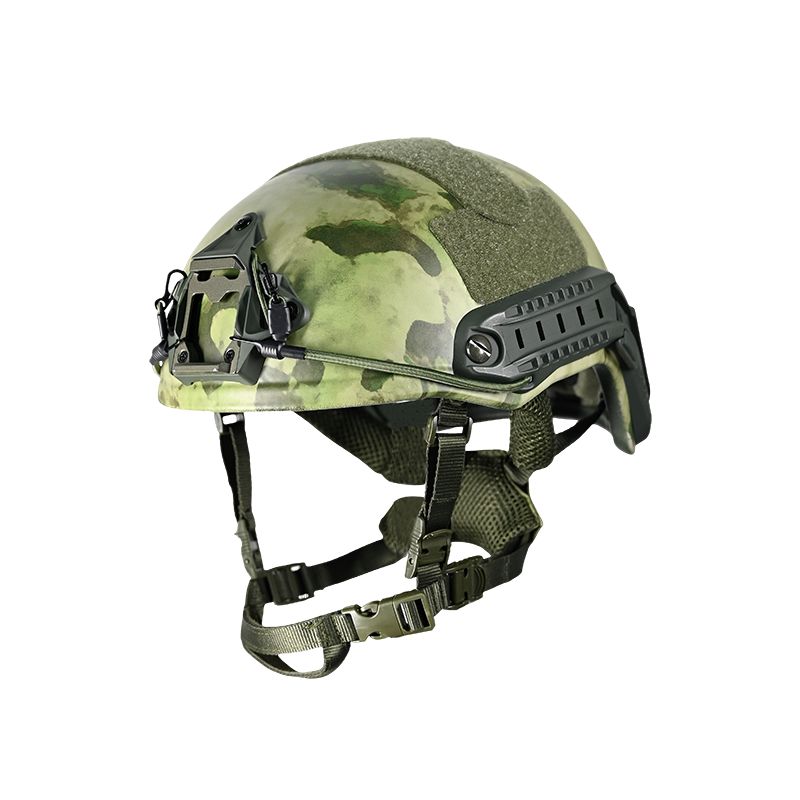How Have Bulletproof Helmets Evolved to Provide Enhanced Protection and Comfort in High-Risk Situations?
2025-02-24
In today’s world, where security and safety are of utmost concern, bulletproof helmets have become a critical piece of protective gear for individuals working in high-risk environments. Whether used by military personnel, law enforcement, or security forces, these helmets are designed to offer life-saving protection in dangerous situations. But how have bulletproof helmets evolved over the years to provide not only enhanced protection but also comfort and usability? In this blog, we will explore the evolution of bulletproof helmets, their advanced materials, and their role in improving safety during critical operations.
What Is a Bulletproof Helmet?
A bulletproof helmet, also referred to as a ballistic helmet, is a type of headgear designed to protect the wearer from impacts and projectiles, including bullets. Unlike standard helmets, bulletproof helmets are specifically engineered with materials that can absorb and disperse the energy from bullets, shrapnel, and other high-velocity threats. These helmets are typically worn by military personnel, police officers, and private security in high-risk situations such as combat zones or active shooter incidents.
In addition to ballistic protection, modern bulletproof helmets often come with added features such as communication systems, night vision mounts, and lightweight materials for comfort during extended wear.
How Have Bulletproof Helmets Evolved?
Bulletproof helmets have undergone significant advancements in both design and materials over the years, leading to helmets that are lighter, more durable, and more effective at protecting the wearer.
1. Materials Advancements
One of the key factors contributing to the evolution of bulletproof helmets is the development of advanced materials that provide better protection without compromising comfort. Early bulletproof helmets were often made of steel, which provided excellent protection but was heavy and cumbersome.
Today’s helmets are typically made from materials like Kevlar, carbon fiber, and polycarbonate, which offer superior strength and impact resistance while being much lighter than their steel counterparts. Kevlar, for example, is a high-strength synthetic fiber used in many bulletproof vests and helmets, known for its ability to absorb the energy of bullets and shrapnel.
Other materials like Twaron and Dyneema are also used in helmet construction, providing both bulletproofing capabilities and resistance to fragmentation. The lightweight nature of these modern materials ensures that soldiers, police officers, and security personnel can wear the helmet for extended periods without experiencing excessive fatigue.
2. Design Improvements
In the past, bulletproof helmets were often bulky and uncomfortable, with limited adjustability to fit different head shapes. Today, manufacturers have focused on creating helmets that are not only protective but also comfortable and ergonomic. Modern helmets come with adjustable chinstraps, cushioned liners, and padded interiors to ensure a snug fit and comfort during long operations.
Furthermore, helmets are designed with better ventilation systems, allowing for air circulation to reduce heat buildup inside the helmet. This feature is especially important for personnel in hot and humid environments, where sweating can lead to discomfort and reduced performance.
3. Enhanced Protection Features
In addition to ballistic protection, modern bulletproof helmets offer a wide range of additional features to increase the safety and effectiveness of the wearer. Some of the key features include:
- Visors and face shields: Many bulletproof helmets come with optional visors or face shields made from bullet-resistant materials that provide protection for the face and eyes as well as the head.
- Side protection: To protect the sides of the head and neck from projectiles, some helmets include additional protection or extensions that can be added to the sides of the helmet.
- Integrated communication systems: Many modern helmets come with built-in communication systems that allow for easy communication between team members, especially in noisy and high-risk environments. These systems can include radio systems, microphones, and speakers built into the helmet or attached via a headset.
- Mounting systems for additional gear: Bulletproof helmets are often equipped with rails or mounts for attaching accessories such as night vision goggles, cameras, flashlights, and other essential equipment that improve the functionality of the helmet in various operational settings.
4. Modularity and Customization
One of the most important trends in the development of bulletproof helmets is modularity. Modern helmets are designed to be highly customizable, with the ability to add or remove accessories based on the specific needs of the wearer. This modularity allows for a tailored experience, ensuring that the helmet is suited for a wide variety of missions and environments.
For example, some helmets allow for the attachment of different ballistic visors, or the helmet can be fitted with a full face shield for additional protection. Other helmets can accommodate attachments like camera mounts for surveillance purposes or impact sensors to alert the team if a blow to the head occurs.
5. Increased Durability and Impact Resistance
While the primary function of a bulletproof helmet is to protect the wearer from gunfire, modern helmets also offer increased durability against blunt force trauma. Advances in material science have led to helmets that can better withstand blunt impacts such as punches, kicks, or falling debris. This is important in combat or riot situations, where the helmet may be subjected to more than just gunfire.
Bulletproof helmets are also designed to provide protection against multiple impacts. Depending on the design and materials used, some helmets can withstand several hits before compromising their integrity.
What Are the Benefits of Bulletproof Helmets?
1. Enhanced Protection: The primary benefit of bulletproof helmets is, of course, the protection they provide. By protecting the head from bullets, shrapnel, and blunt force trauma, these helmets significantly reduce the risk of head injuries in high-risk situations.
2. Increased Comfort: Thanks to the advancements in materials and design, modern bulletproof helmets are lighter, more comfortable, and less intrusive than older models. Wearers can now wear helmets for longer periods without experiencing discomfort or fatigue.
3. Improved Mobility: Modern helmets are designed to be more streamlined, allowing wearers to move their heads freely without obstruction. This allows for better situational awareness and easier movement, especially in fast-paced environments like combat or law enforcement operations.
4. Versatility: Bulletproof helmets can be used in a variety of settings, from military and law enforcement to civilian protection in dangerous situations. Their versatility makes them an essential piece of equipment for anyone working in high-risk industries.
Conclusion
In conclusion, bulletproof helmets have come a long way from their bulky, uncomfortable predecessors. With advancements in materials, design, and additional protective features, these helmets now provide enhanced protection, comfort, and functionality for those who rely on them in high-risk situations. As technology continues to evolve, we can expect bulletproof helmets to become even more effective and adaptable, further increasing the safety of those who wear them. Whether on the battlefield, in law enforcement, or in other dangerous environments, these helmets are a crucial piece of equipment that helps save lives and protect individuals from harm.



